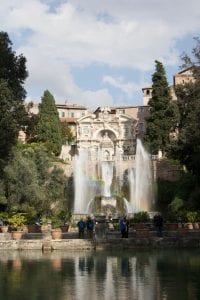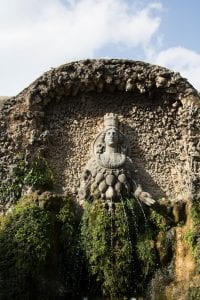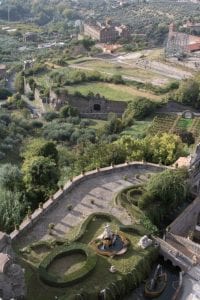The morning of the Tivoli field trip, I woke up at 6am to make myself four sandwiches. I knew I needed that much energy to get through the day, because we were going to a Roman Imperial villa the size of a city with Professor Jan Gadeyne. From my experience in Pompeii, one sandwich was not enough.
Hadrian’s Villa, or more Italian ‘Villa Adriana’, is located just an hour away from Rome’s city center; we got there so quick that I didn’t have time to nap on the bus. Jan talked about the Villa’s history: it served as a retreat for Emperor Hadrian, following the tradition of many other Roman Emperors building their own retreat (such as Nero’s retreat in Anzio, which I visited earlier in the semester) and it is said that the property belonged to his wife Sabina. Hadrian’s villa, however, was not only a retreat: it also served as the official seat of government in his later years, with a large court residing in it permanently. The proximity to Rome made this possible. It made sense, then, that the ‘villa’ is the size of a city.
Jan lead us through the enormous villa building by building, pointing out interesting features such as how a wall turns into a column at the end, or well-preserved fragments of ceiling stucco decoration, or intricately carved bases of ionic columns. He made sure the 25 of us in Jeffrey’s class paid attention too: many architects of Renaissance and beyond visited Villa Adriana and were inspired by its forms, one of those architects being Borromini. We can see the influence of Hadrian’s Piazza d’Oro on San Carlo alle Quattro Fontane’s plan. Of course with a very Jan commentary on each: “How can I get that stubborn head of yours to look up!” We were released from our running tour at the artificial lake Canopo where a summer dining table stands, and my more artistic friends occupied a stump to sketch. I took photos of the turtles that were bathing in the murky green water.
Much to Professor Jan’s dismay, but perhaps to Professor Jeffrey’s delight, marble and statuary of Villa Adriana was brought to Villa d’Este, our next destination in the day trip, for its decoration in the 16th century. We learned about this villa in Jeffrey’s history class earlier, so after a short introduction we were allowed to roam free for two hours in what was one of the most memorable sites I’ve visited this semester.
Villa d’Este was Cardinal d’Este’s project to console himself from the fact that he would never become Pope. And what a villa he built! I would take his garden any day over being pope. We entered the villa from the top, where the residence was, so the garden was a surprise when we got to the other side. What seemed like a modest, relatively normal sized building (well, for a Renaissance cardinal) became an expansive garden with more water fountains than Disneyland. I never knew there could be so many ways to spurt water out of a pipe: some were arranged in neat rows of 3×100?? (I didn’t actually count, my point is that there were a lot), some from artificial grottoes that looked like a Ghibli scene, some even came out of nipples of…goddesses? Sphynx? I was amazed that they got so much water delivered to this villa, and that they had the technology to do this in the 16th century. I remember visiting a fountain back home in Japan which is said to be Japan’s first fountain in the Kenrokuen gardens; it is comparably a lousy water spout, and it was only built in the 17th century.
The actual entrance at the bottom of the villa seemed quite modest, it’s scale fitting in with the neighboring buildings, although this may not have been the case back when it was first built. Grape vines covered a walkway that then lead to the overwhelming garden. My friends and I imagined we were esteemed guests of the Cardinal, being invited to his home, and walking up towards the building. What a power move it must have been to make guests walk all the way up (or where carriages allowed?), boasting the huge property, well-kept gardens, technological innovation, and fascinating design. It was a great place to cool as well, especially behind the larger water fountains.
The garden wasn’t the only part of the villa that was impressive. The frescoes in the rooms were all breathtaking. Jan told us that most of them were inspired by Roman 4th style painting with its perspective illusions looking out into landscapes. There is also a lookout wing to take in the panoramic view of Tivoli.
Later, when my friends and I were asked what site we enjoyed the most visiting during our semester in Rome, I replied: Villa d’Este. I would definitely go there again, next time with my watercolors.

My friends and I in front of a fountain in Villa d’Este
Ami Kurosaki





